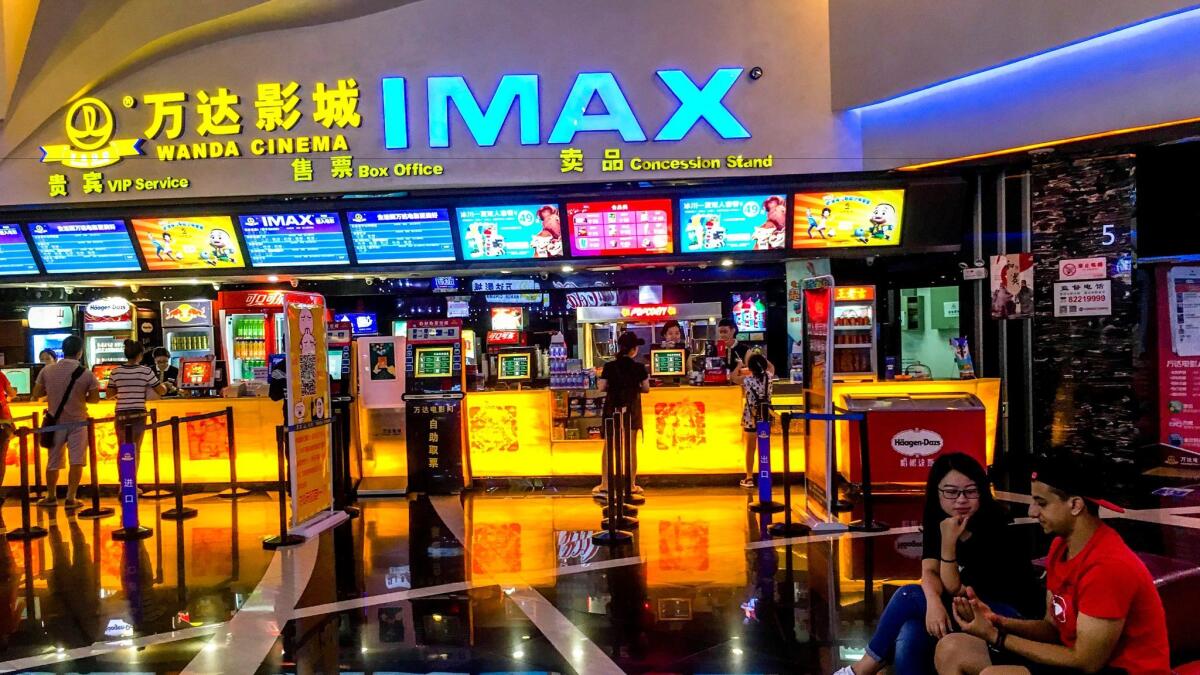Global box office barely grew in 2016. Blame it on China

Global movie box office revenue growth slowed last year as international receipts declined for the first time in 12 years, reflecting a cooling in China’s once-red-hot film market, according to a new report.
The total worldwide box office rose 1% to a record $38.6 billion in ticket sales last year, according to a report from the Motion Picture Assn. of America, the lobbying group that represents the six largest film studios. In 2015, global revenues jumped 5%.
The leveling off at the box office underscored sluggish movie ticket sales in countries outside the United States and Canada. Foreign box office totaled $27.2 billion in 2016, down from $27.3 billion in 2015, thanks to a dramatic slowdown in box office growth in China. The increased value of the U.S. dollar compared with other currencies also dampened ticket revenues, the association said in a report released Wednesday.
“The Chinese market is a little concerning,” said Jeff Bock, a box office analyst for Exhibitor Relations. “They thought it was going to be some magical potion, and it’s not.”
Though the drop in foreign ticket sales was less than 1%, it’s the first time the international box office has failed to grow since 2005. That’s a worrisome trend for an industry that has grown increasingly dependent on the global marketplace. International markets made up 71% of the global box office in 2016, compared with 63% a decade ago.
The slowdown in China was particularly jarring for the industry, coming after years of speculation that the country would soon surpass the United States and Canada as the world’s largest film market.
Revenues from China fell 1% to $6.6 billion in 2016, in U.S. dollars, a surprising downturn from 2015, when ticket sales grew by 49%. A variety of factors hurt the box office in China, including a series of sub-par movies, a lack of discounts by China’s online ticket sellers, and greater government scrutiny of bogus box office statistics.
Foreign currency declines in countries such as Mexico, Argentina and Britain also depressed revenues in U.S. dollar terms. The British pound, for example, fell 12% against the dollar last year.
“A major issue is currency,” said Julia Jenks, vice president of worldwide research for the MPAA. “It’s hiding a lot of growth,”
The statistics were brighter for the domestic market.
Box office receipts hit a record $11.4 billion in the United States and Canada, up 2% from 2015, thanks to blockbusters such as “Rogue One: A Star Wars Story,” “The Secret Life of Pets,” and “Captain America: Civil War.”
Nonetheless, the industry is facing some troubling head winds, including long-term stagnation in the number of tickets sold. Admissions totaled 1.32 billion last year, flat compared with 2015, and down from 1.4 billion a decade ago. The slide in attendance underscores the rising competition cinemas face to lure younger audiences who have more entertainment options in the home. Per capita attendance in the United States and Canada slipped 1% to 3.8 last year.
Despite the flattening attendance, revenue still grew because of an increase in ticket prices. The average ticket price hit a record $8.65 in 2016, according to the National Assn. of Theatre Owners, the result of cinema chains adding more advanced screening technology and more luxurious accommodations such as recliner seating.
“The question is, what’s going to drive the North American box office to the heights we saw 10 to 20 years ago in terms of attendance?” Bock said.
Some young people went to the theaters more often last year. People ages 18 to 24 bought an average of 6.5 movie tickets in 2016, up 10% from 2015. Yet, the movie business took a hit among 12-to-17-year-olds, who went to the movies 16% less frequently than in 2015.
Another issue was the continued slide of the Latino audience, once the most reliable cinema audience. Latinos purchased an average of 4.6 movie tickets in 2016, a drop of 11%, even as movie studios spoke about efforts to increase the diversity of their films. In contrast, attendance surged among Asians and African Americans. Asians visited an average of 6.1 times last year (up 24%) and African Americans visited 4.2 times last year (up 20%).
“There is an effort among to studios to do a better job to achieve representation,” said Christopher Dodd, chairman and chief executive of the MPAA. “We’re trying to do a better job, and it deserves being done.”
Executives at the trade groups emphasized that revenue still hit record levels in a year that many analysts had predicted would be down.
So far this year, the domestic box office is up about 5% compared with the same period last year, because of high-profile hits including Jordan Peele’s horror movie “Get Out” from Universal Pictures and Blumhouse Productions, as well as Disney’s live-action remake of “Beauty and the Beast.”
“Yes, there’s disruption, but people are still going to the cinema in large numbers,” said John Fithian, president and chief executive of the National Assn. of Theatre Owners, the trade group for the exhibition industry.
Twitter: @rfaughnder
More to Read
Inside the business of entertainment
The Wide Shot brings you news, analysis and insights on everything from streaming wars to production — and what it all means for the future.
You may occasionally receive promotional content from the Los Angeles Times.











